From Community, For Community: The Rise of the Free Fridge
Community fridges have been around for more than a decade, but they rose in popularity over the COVID pandemic. Why has this form of mutual aid become so popular?
From Community, For Community: The Rise of the Free Fridge
Community fridges have been around for more than a decade, but they rose in popularity over the COVID pandemic. Why has this form of mutual aid become so popular?
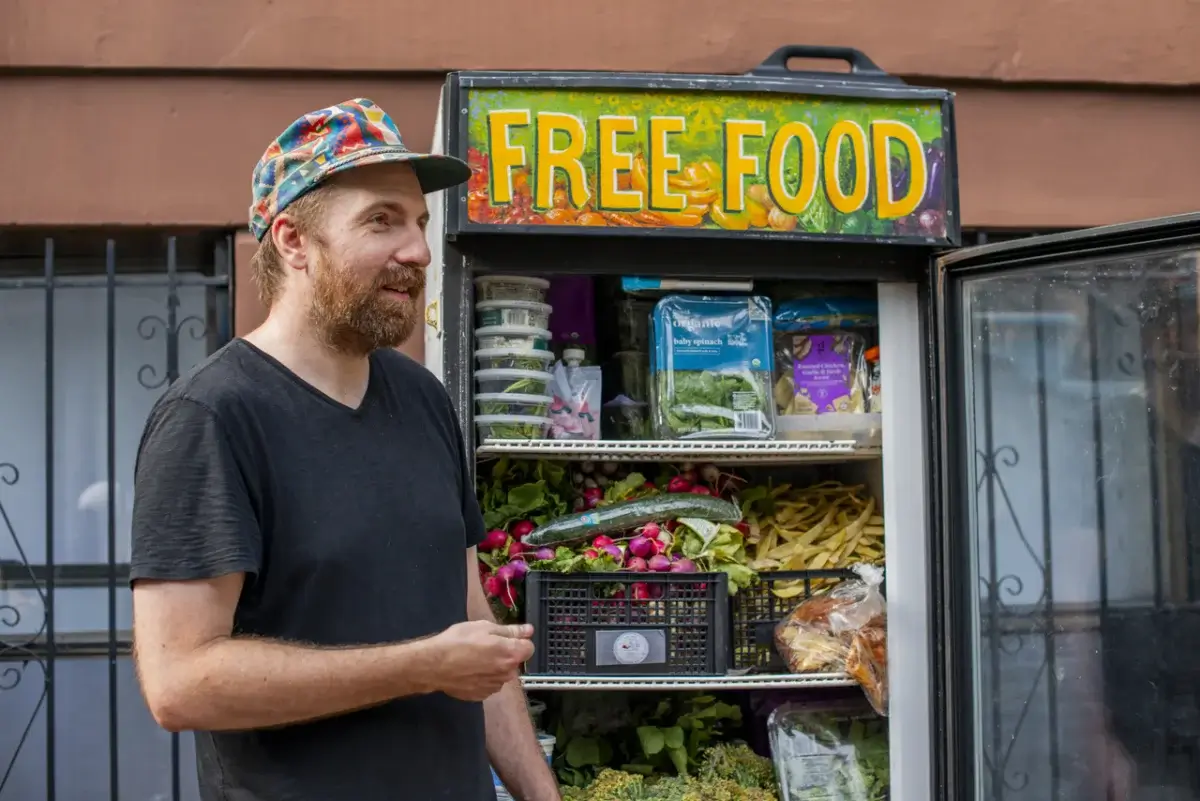
Thadeaus Umpster with the fridge he set up in his Brooklyn neighborhood. by Emma Kazaryan.
Thadeaus Umpster hates waste. “There’s so much labor and effort that goes into growing and making good, healthy food, and a huge percentage of it is wasted every day,” he says . “That hurts me at the soul level.”
Preventing waste is one of the main motivations that drives Umpster and has been for the almost 30 years he’s been organizing in his Brooklyn neighborhoods, but it’s not his only one.
Umpster knows what it’s like to be hungry. As a teenager, he began volunteering with Food Not Bombs, a mutual-aid group dedicated to feeding folks in his community. But when his shift was over, he would “load up my bag with food, instant oatmeal and stuff like that, to get me through the weekend before I went back to school.”
But it wasn’t until 2020 that Umpster opened his first community fridge- right in front of the building where he lives. In Bed Stuy, Umpster’s neighborhood in Brooklyn, food insecurity and access was already a problem when the pandemic hit. By February, Umpster could see more of his neighbors struggling to feed themselves and their families.
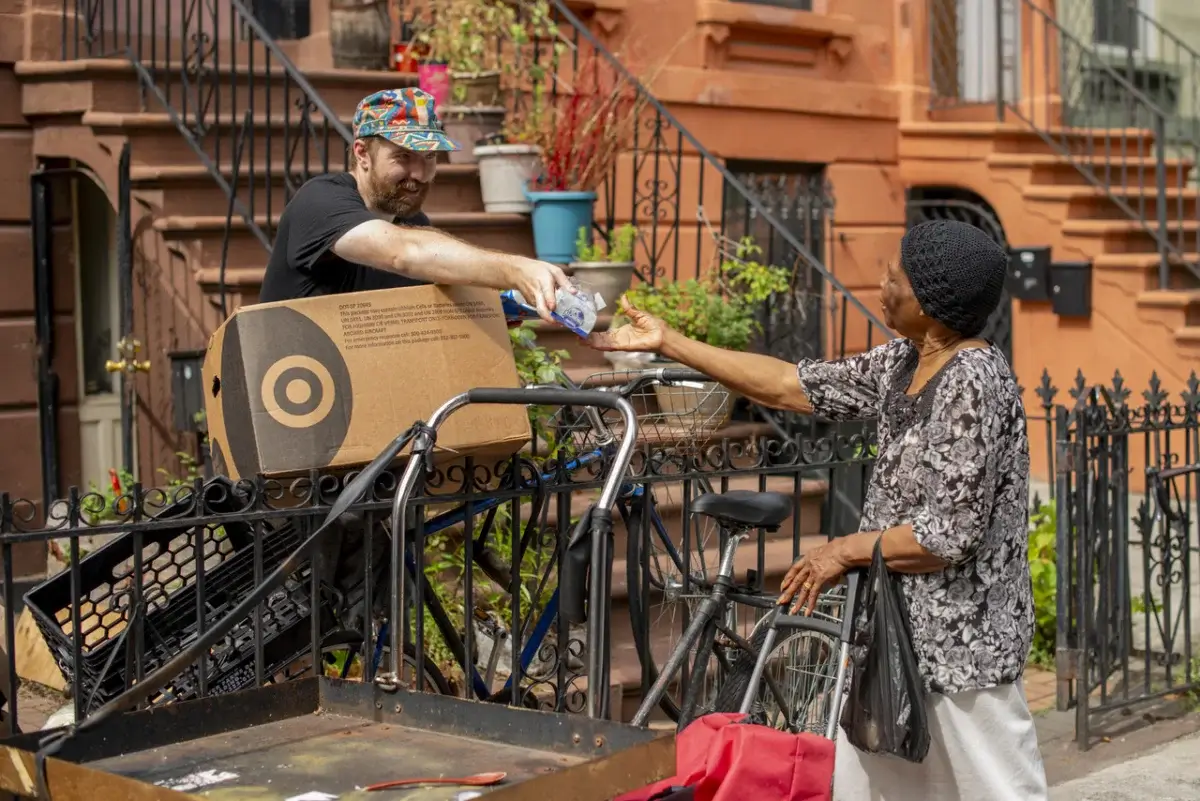
At first, he mostly promoted the fridge and its offerings in the free section of Craigslist. “I’d be like, ‘we got a bunch of free bagels today, a bunch of salad greens…come by the fridge, take what you want, leave what you want,” says Umpster. The fridge began gaining traction in his neighborhood, and he began promoting it on other social platforms such as Instagram. Then, one of his posts was reshared by a popular local radio station, and it took off.
Umpster got a call from a friend in neighboring Crown Heights and Flatbush and then the Bronx who wanted to start a fridge, so he helped find a few on Craigslist and fill them with food. “Before long, people were setting up fridges without even getting in touch with me, which is awesome. People just started moving.” The mutual-aid network In Our Hearts NYC helped organize groups and fridges where each neighborhood runs independently but they are all in contact with each other. Umpster describes the group as collectively or “anarchistically” organized, meaning there’s no hierarchy.
For many, the community fridge serves multiple purposes. It’s a tangible way to help your neighborhood, as food prices continue to rise, and it helps reduce food waste. But it’s also a meeting place and community space, a way to start a conversation with your neighbors. “I have these really tight connections and bonds with people who live on my specific block. And there are a lot of people who I used to just kind of nod to when I went down the street and maybe wave and smile, maybe say hello. And now we know each other intimately. We spend holidays together, we work together on projects, and it’s pretty incredible. The neighborhood comes to the fridge a lot,” says Umpster.
Where it all started
Community fridges have been around for a while. They go by different names, such as “free fridge” or “community pantry,” but the aims are pretty simple. First, they help to alleviate food waste, and second, they directly address food insecurity.
The rates of food insecurity shot up during the pandemic, with two peaks. The first was at the start of the pandemic, as people lost jobs and so much was up in the air. And the second peak happened once COVID supports ran out. In 2022, 17 million households in the US reported trouble finding food, which is additionally frustrating considering the amount of food that ends up in landfills.
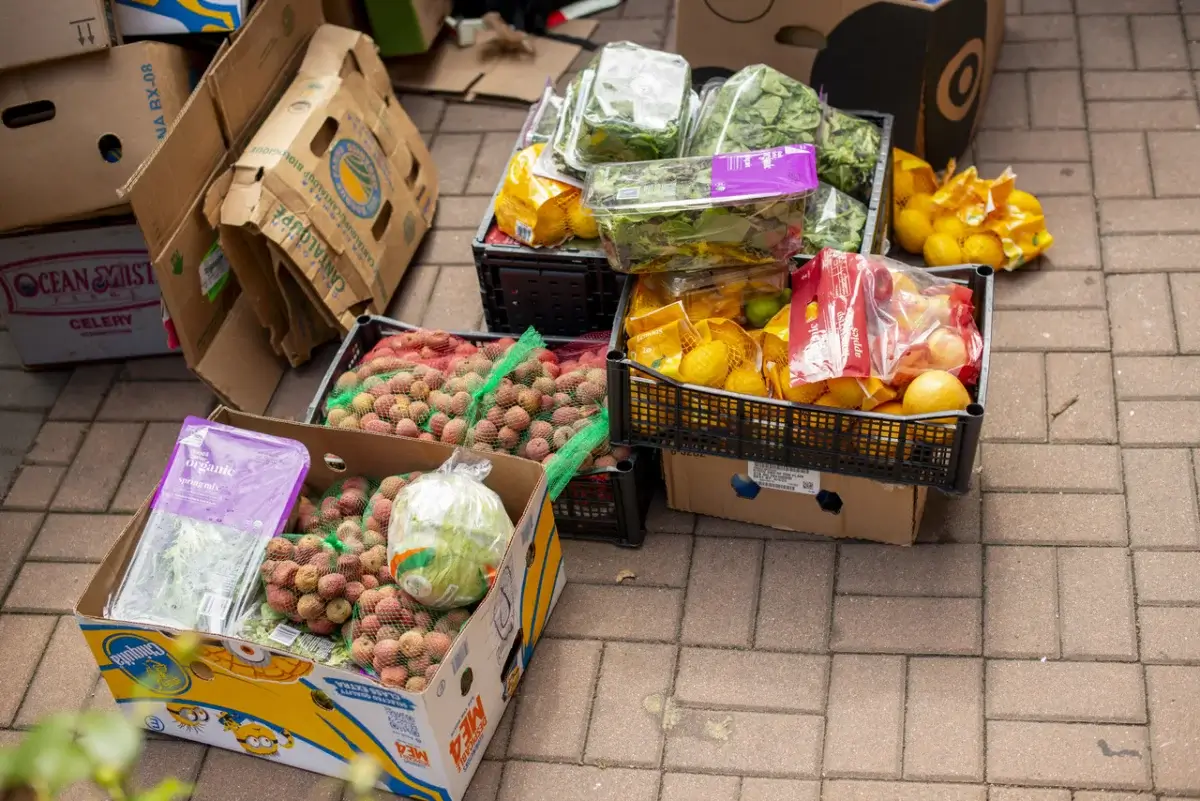
The amount of food waste in North America is staggering. In the US, close to 40 percent of food is wasted, with 92 billion pounds of food thrown away each year. Canadians create 50 million tonnes of food waste every year, but there are estimates that more than half of that waste could be prevented.
That’s where community fridges come in.
The food comes to fridges in one of three main ways. Ideally, organizers have consistent larger donations from grocery stores and other retailers. If a grocer has a load of apples, juice boxes or lettuce and they know it will pass the sell-by date, they will often partner with a community fridge. Volunteers will pick up the load of food and stock the fridges as food becomes available. Then there are individual donations. These can be leftovers from your dinner or a loaf of bread you grabbed at the grocery store that you don’t need. For many fridges, neighbors can pick up what they need and drop off what they have to give. Lastly, there are the restaurant donations. Just like retail stores, some restaurants partner with community fridges to pick up unsold meals and redistribute them.
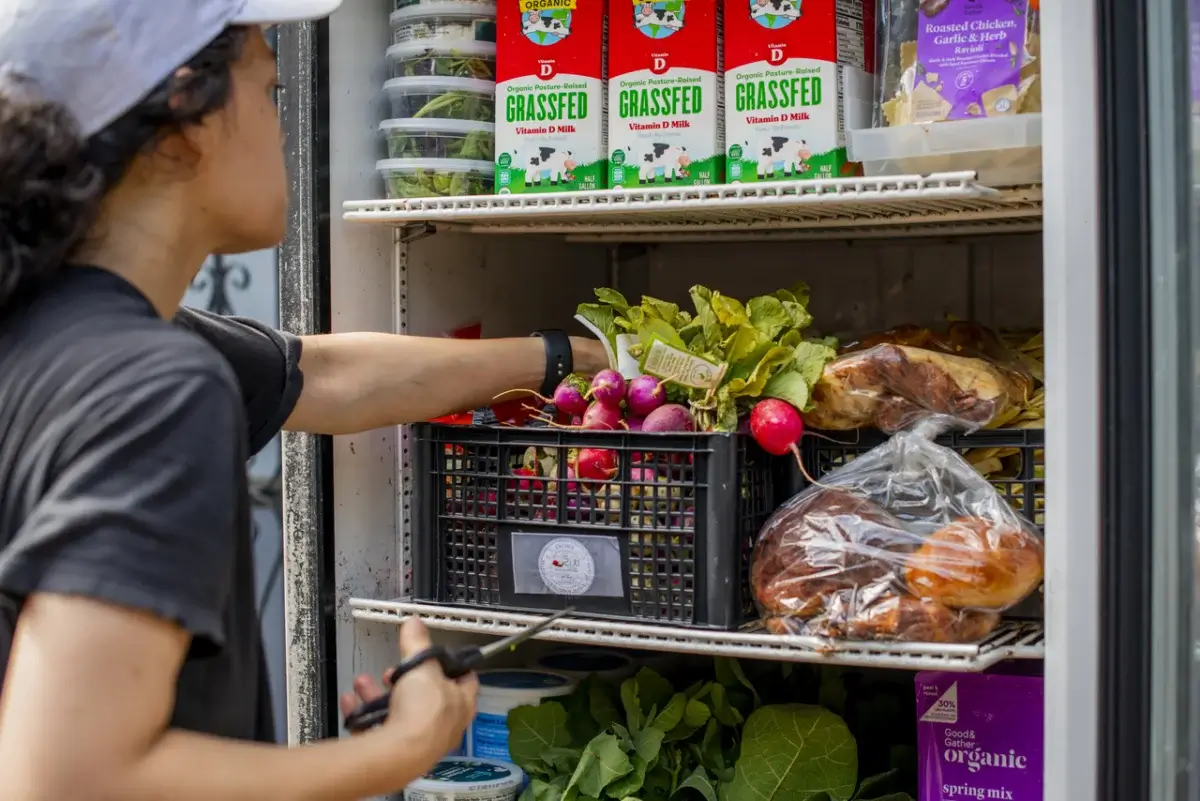
Independent fridges exist everywhere, with more than 600 recorded across the UK. In Canada, there are fridges in nearly every province; likewise in every state across the US. There are fridges in Singapore, Australia, Sweden and myriad other countries. Eighteen states across the US, including North Carolina, Colorado and Iowa, have even introduced legal protections for community members who run the fridges. Those protections are helpful, as most of the fridges are run by volunteers—this is a solution led by community members for community members, so volunteers often live in the neighborhood. They help clean the fridge, stock it and do regular checks to make sure everything is working properly.
Unsurprisingly, some of the biggest cities in the US have the most active networks of community fridges. In New York City, there are fridges across all five boroughs. One of the best tools they have is social media. The volunteers have text threads, a Signal chat, and they post often on Instagram, TikTok and other platforms. In their chat, they are often coordinating pickups of food from restaurants or retail stores and deliveries to various fridges around the city.
The blueprint
There’s no one way to run a community fridge. But if you’re looking for a blueprint, start with Davis, California.
About a decade ago, when Ernst Oehninger was a grad student at the University of California, Davis, he put a fridge in his yard. It was a shared house; he lived there with other UC Davis students, and they had an extra fridge. Why not put it outside, where it was accessible, and share food with their neighbors, some of whom were other students?
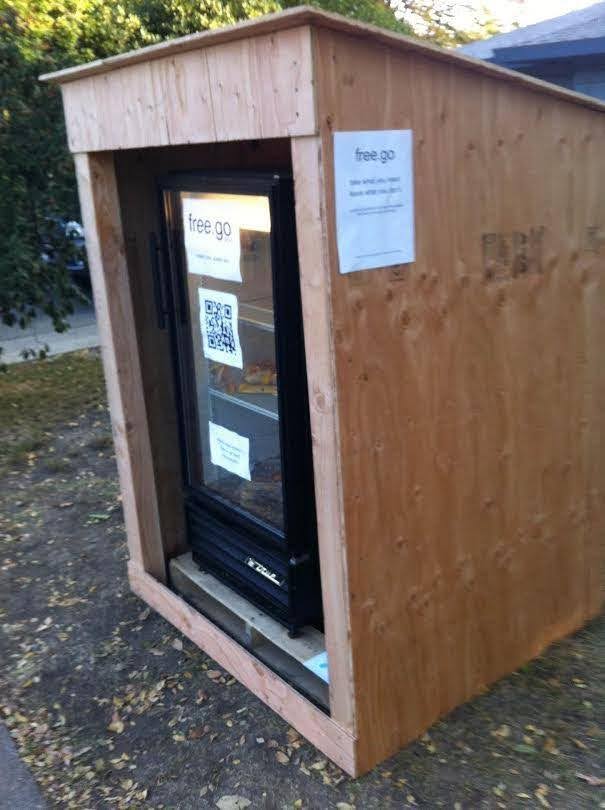
That fridge lasted for a few months, and it was refilled by Oehninger, his housemates and, occasionally, some neighbors. He was feeding people in his neighborhood, and his community was coming together. But, things got serious after a few months. Some neighbors complained; they had some worries that having a free fridge would encourage unhoused people to frequent the neighborhood, and that it would in turn be a safety concern. That didn’t happen, says Oehninger, but there was some pushback.
“We started having food safety inspectors called, since we didn’t have any food safety licenses. So, the fridge was shut down,” he says. What was frustrating, he recalls, is that what was considered appropriate by one health inspector might be condemned by another; there were no guidelines for community fridges at the time. But, by that point, he was invested in the project. Oehninger spent a year, with his housemates and friends, researching and negotiating with the health department, trying to find a way to have a free fridge on their property.
And not just their property. Once they worked with the health department to produce guidelines, they started expanding into other neighborhoods, installing fridges at homes, outside of willing businesses or churches with food banks. By 2017, Oehninger’s project had grown large enough that he incorporated, which would allow him to get better insurance and be protected by laws such as the Good Samaritan Food Donation Act, which protects people who donate food from legal liability if someone gets ill.
Just like that, Freedge was born.
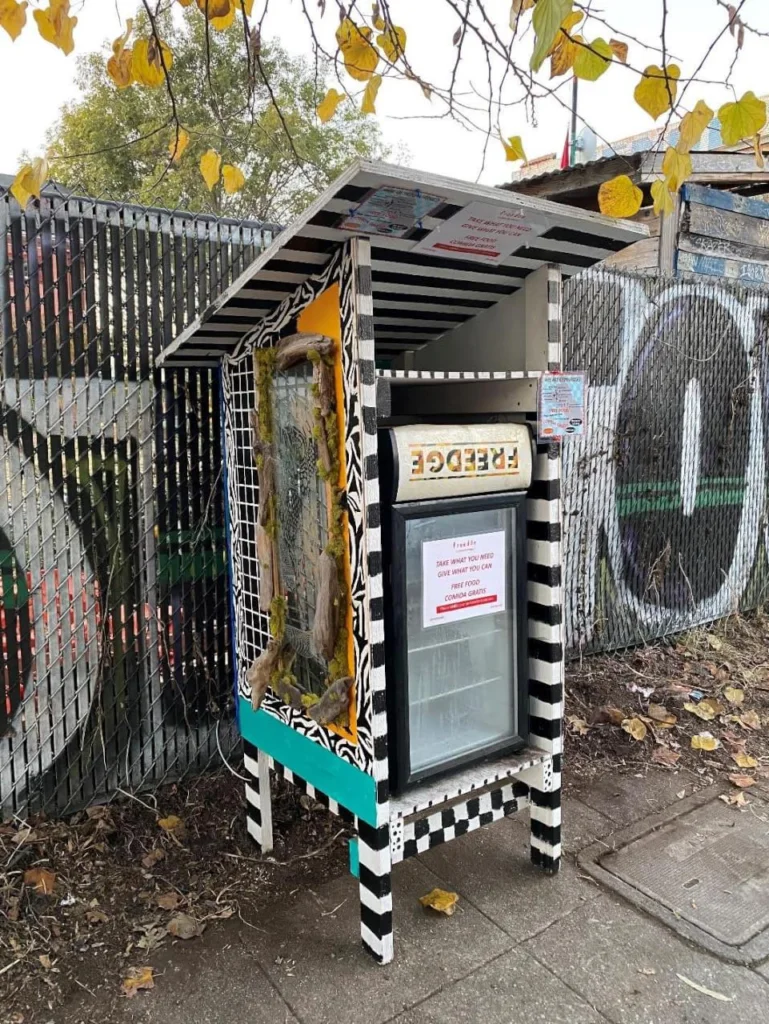
Oehninger and his team (he had enough community members come together at this point to have a team) started tracking other community fridges in the region. They found examples in the Bay Area and Los Angeles. Word started to spread, and people in other states began reaching out and asking for advice on how to start their own fridges. “There was one in Colorado we helped set up. There was another one in Texas, and there was one in DC. We put that one in touch with [a group] in Florida,” he says. They had started with about 20 fridges in their region before the pandemic. By 2021, they had a network of more than 400 fridges nationwide.
Now, Freedge, an official nonprofit organization, acts as an unofficial overseer. It has a section on its website offering tips and guides to folks who want to start their own fridge, including food safety protocols and how to deal with health inspectors. There’s a group Slack channel for fridge coordinators across the country to chat with each other. Freedge still maps and tracks free fridges across the country and even gives out micro-grants to other groups that want to join its umbrella network to start a community fridge.
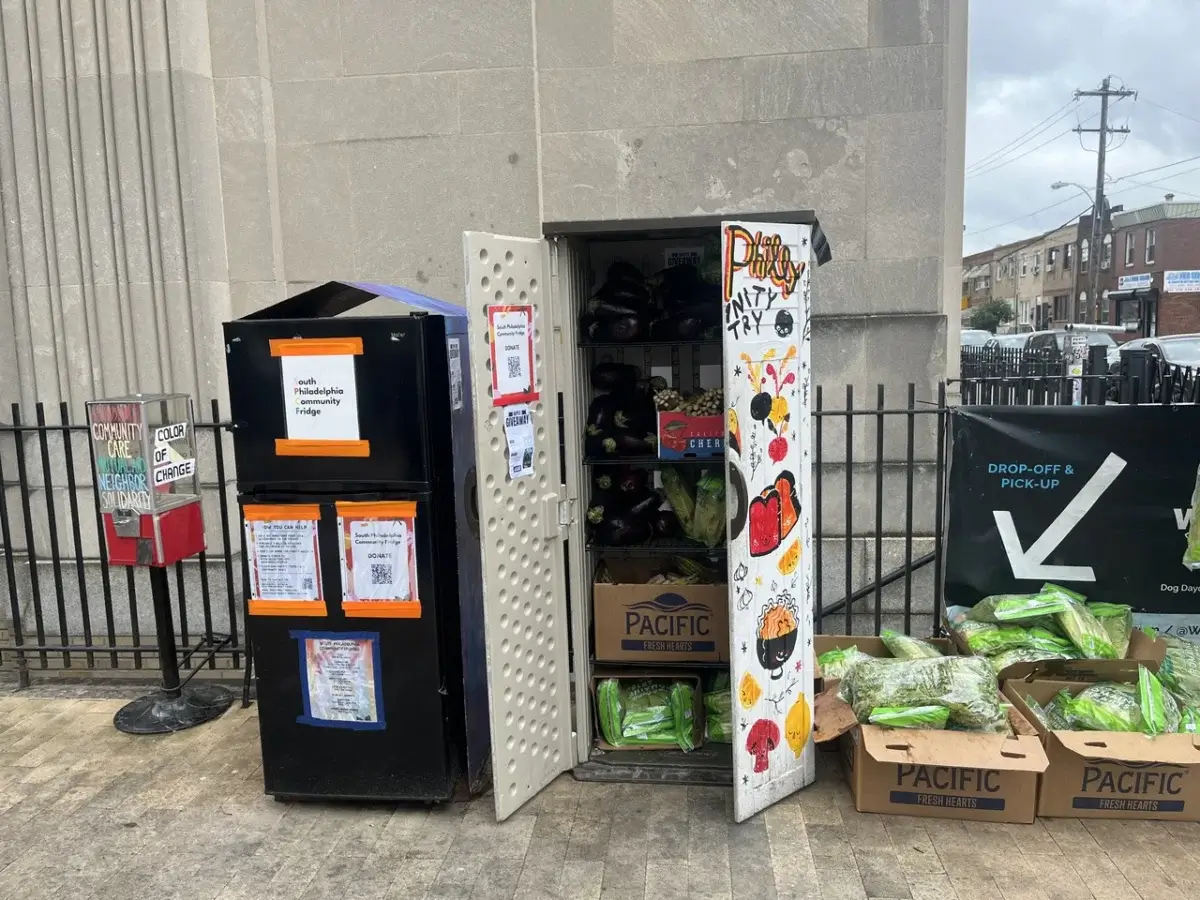
The community is growing
During the pandemic, four new fridges popped up in Los Angeles. That’s now grown into Los Angeles Community Fridges (LACF), with more than a dozen locations.
Julie Haire started volunteering with LACF in 2021, when the pandemic highlighted food insecurity around the country. Haire had always been focused on food waste, often dropping excess food off at local church pantries. But when she connected with LACF and saw how wide community fridges could spread, she was hooked. One of the most inspiring things, says Haire, is how LACF “deputizes the community” to help maintain each fridge. If a volunteer checks the Los Feliz fridge and finds that, for instance, someone threw mashed potatoes all over it, “we could put it up on Instagram and ask ‘can someone help us clean this?’ and luckily, someone from the community will go do it,” says Haire. “We put out the call, and the volunteers go in.”
Film sets are a particularly fruitful source for fridges in Los Angeles and NYC. Craft services and catering from the film and television industries make a lot of food, and typically, a lot gets wasted. Haire and other fridge volunteers in LA try to connect with as many sets as possible to pick up that extra food—some of it straight from a fresh take. “I went to a filming, I think it was The L Word. And they were doing a grocery scene, and they had all of this really nice produce [in the background]. They had huge things of flour and Crisco and spices, all of this stuff that they would not know what to do with ]after filming].” Naturally, Haire was happy to take it off of producers’ hands when filming wrapped up.
South Philly Community Fridge (SPCF) in Philadelphia, started up in August of 2020 and has grown to include fridges at six locations, with a roster of about 75 volunteers. They’ve found a unique way to raise awareness of their fridges–merchandise, including mugs, sweatshirts and tote bags. All of the designs were conceived by local artists, and they are playful and eye-catching. “I was at a museum with my husband and he was wearing one of our shirts, and someone stopped us and said ‘we’re from New Jersey, and we want to start a community fridge. So we exchanged emails,” says SPCF’s Victoria Jayne. “We want to have fun with the merch. It’s fun to show up.”
It’s also easy to grab attention from the community when the fridges are colorful and cute. Like many organizations, the LACF encourages community members to decorate and paint their fridges with eye-catching designs, posters, signs—anything to make them stand out and get people involved. The one in Inglewood has a motif of bananas; the Los Feliz fridge features a dancing hot dog with a top hat. It’s fun and quirky and highlights the fridges as a community project.
Myth busting
There are some myths about who uses community fridges. The biggest one, says Jayne, is the idea that community fridges are for a specific type of person.
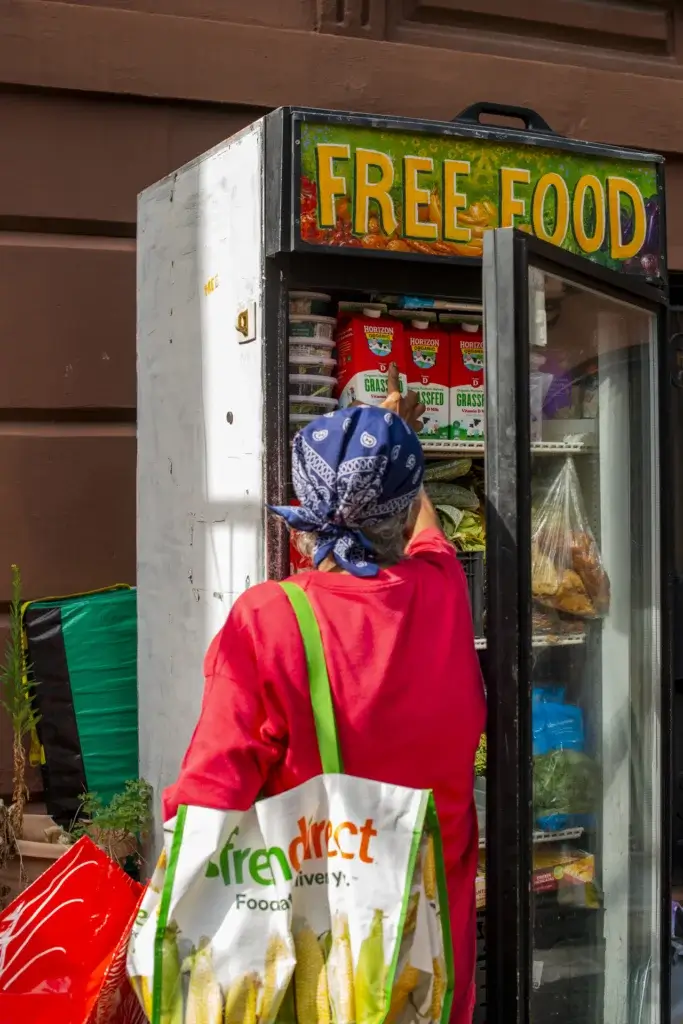
“Something we really try to stress about mutual aid is that it’s here for everybody and anyone. It doesn’t have to be something that’s means tested,” she says, meaning that there’s no prerequisite for using the fridge. No one is going to check your income level or try to determine how much food you “need.” Jayne says that, in her neighborhood, she’s seen people who work full time and don’t have access to traditional food pantries use the fridge or people without cars who can’t drive to out-of-the-way food banks. “Something that people have asked me or other volunteers in passing is ‘how do you know the person who’s taking food really needs that?’ and I’m like, ‘I haven’t met anyone who didn’t need to eat to live.’”
Another myth that Haire works to bust in Los Angeles is the idea that a fridge will attract unhoused people to the neighborhood in the first place. “We have a fridge in Eagle Rock that is outside of a community center, and neighbors complain all the time because of the homeless problem. And we’re like, is it the fridge? Or is it that it’s 2024 and we’re experiencing unprecedented numbers of people living on the streets right now?” For Haire, those are even stronger reasons to continue the fridges, not a reason to stop.
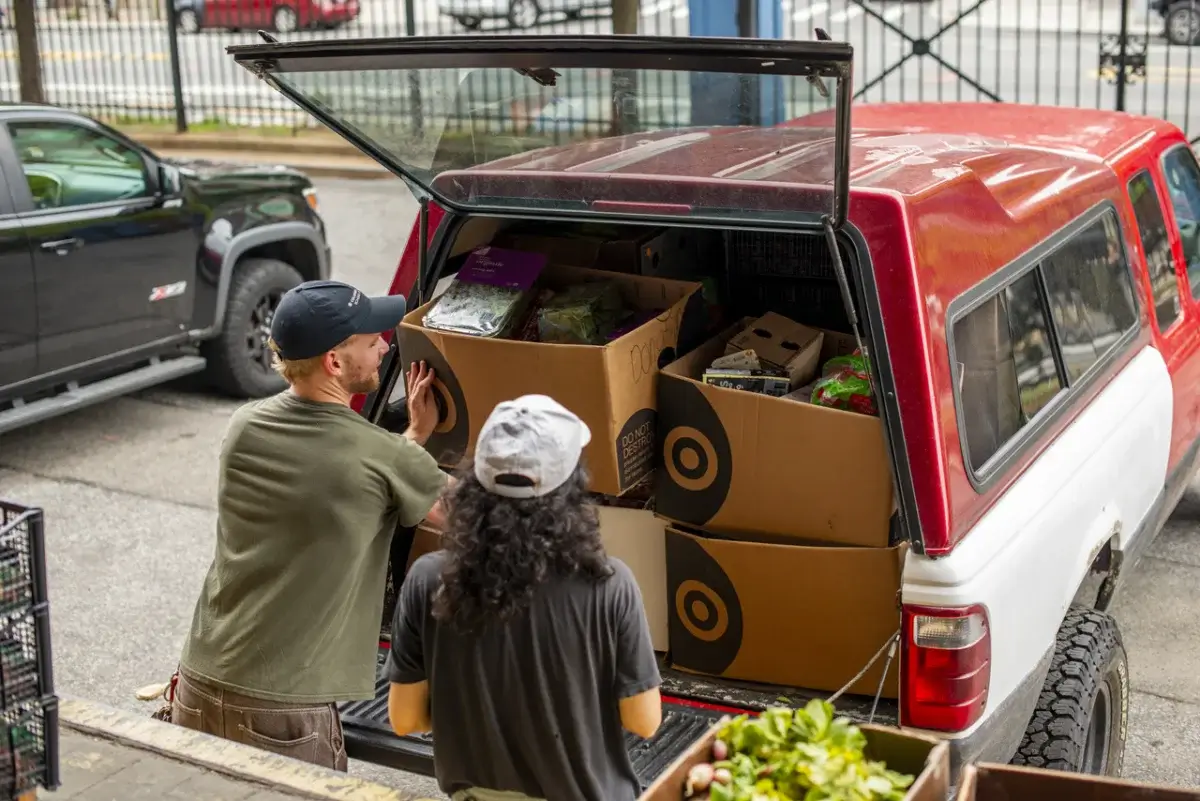
The fog has lifted
Although the Philadelphia group started during the beginning of the COVID pandemic, Jayne says the need has only grown since then. In August of 2020, there were job losses and many struggled getting to the grocery store. But, there were also enhanced safety nets for people. “There was additional money for unemployment, additional money for SNAP, and there was the child tax credit,” says Jayne. “As we’ve come out of this period of active pandemic, we’ve seen those benefits taken away from people, and that’s resulted in significantly higher usage.”
When Ernst Oehninger, from Freedge, thinks about the period just before the pandemic, he likens it to a fog that blanketed our collective consciousness before 2020 and dissipated in the midst of lockdowns and COVID protocols. As a community, many were confronted with the number of systemic issues facing everyone, from police brutality around the murder of George Floyd to lack of health care, climate change, and food insecurity. “People started thinking about how they were relying on the state for this or a corporation for that,” says Oehninger. “And a lot of people started realizing that they could work with their community instead.” While Oehninger says some of these issues are inherent to the US, he did clock an expansion of mutual aid programs globally during that time.
Oehninger says part of what makes the fridges such an attractive option for users is the dignity it affords people. Sadly, there’s still a stigma attached to using a food bank, and there can be administrative hurdles in the process. “A free fridge doesn’t ask for my documents,” says Oehninger. Rather, it’s just a group of people coming together to help, no questions asked.
As Jayne puts it, the fridge is an exercise in community. “There’s a Mariame Kaba quote that says ‘everything worthwhile is done with other people.’”
Follow us
This work is licensed under a Creative Commons Attribution-NoDerivatives 4.0 International License.
Want to republish a Modern Farmer story?
We are happy for Modern Farmer stories to be shared, and encourage you to republish our articles for your audience. When doing so, we ask that you follow these guidelines:
Please credit us and our writers
For the author byline, please use “Author Name, Modern Farmer.” At the top of our stories, if on the web, please include this text and link: “This story was originally published by Modern Farmer.”
Please make sure to include a link back to either our home page or the article URL.
At the bottom of the story, please include the following text:
“Modern Farmer is a nonprofit initiative dedicated to raising awareness and catalyzing action at the intersection of food, agriculture, and society. Read more at <link>Modern Farmer</link>.”
Use our widget
We’d like to be able to track our stories, so we ask that if you republish our content, you do so using our widget (located on the left hand side of the article). The HTML code has a built-in tracker that tells us the data and domain where the story was published, as well as view counts.
Check the image requirements
It’s your responsibility to confirm you're licensed to republish images in our articles. Some images, such as those from commercial providers, don't allow their images to be republished without permission or payment. Copyright terms are generally listed in the image caption and attribution. You are welcome to omit our images or substitute with your own. Charts and interactive graphics follow the same rules.
Don’t change too much. Or, ask us first.
Articles must be republished in their entirety. It’s okay to change references to time (“today” to “yesterday”) or location (“Iowa City, IA” to “here”). But please keep everything else the same.
If you feel strongly that a more material edit needs to be made, get in touch with us at [email protected]. We’re happy to discuss it with the original author, but we must have prior approval for changes before publication.
Special cases
Extracts. You may run the first few lines or paragraphs of the article and then say: “Read the full article at Modern Farmer” with a link back to the original article.
Quotes. You may quote authors provided you include a link back to the article URL.
Translations. These require writer approval. To inquire about translation of a Modern Farmer article, contact us at [email protected]
Signed consent / copyright release forms. These are not required, provided you are following these guidelines.
Print. Articles can be republished in print under these same rules, with the exception that you do not need to include the links.
Tag us
When sharing the story on social media, please tag us using the following: - Twitter (@ModFarm) - Facebook (@ModernFarmerMedia) - Instagram (@modfarm)
Use our content respectfully
Modern Farmer is a nonprofit and as such we share our content for free and in good faith in order to reach new audiences. Respectfully,
No selling ads against our stories. It’s okay to put our stories on pages with ads.
Don’t republish our material wholesale, or automatically; you need to select stories to be republished individually.
You have no rights to sell, license, syndicate, or otherwise represent yourself as the authorized owner of our material to any third parties. This means that you cannot actively publish or submit our work for syndication to third party platforms or apps like Apple News or Google News. We understand that publishers cannot fully control when certain third parties automatically summarize or crawl content from publishers’ own sites.
Keep in touch
We want to hear from you if you love Modern Farmer content, have a collaboration idea, or anything else to share. As a nonprofit outlet, we work in service of our community and are always open to comments, feedback, and ideas. Contact us at [email protected].by Emily Baron Cadloff, Modern Farmer
July 18, 2024
Modern Farmer Weekly
Solutions Hub
Innovations, ideas and inspiration. Actionable solutions for a resilient food system.
ExploreExplore other topics
Share With Us
We want to hear from Modern Farmer readers who have thoughtful commentary, actionable solutions, or helpful ideas to share.
SubmitNecessary cookies are absolutely essential for the website to function properly. This category only includes cookies that ensures basic functionalities and security features of the website. These cookies do not store any personal information.
Any cookies that may not be particularly necessary for the website to function and are used specifically to collect user personal data via analytics, ads, other embedded contents are termed as non-necessary cookies.
Excellent. This can solve HUNGER to a great extent,
It emphasizes how initial safety nets were beneficial but have since been withdrawn, leading to increased community reliance and awareness of systemic issues. Jayne notes the growing need for assistance, while Oehninger reflects on a collective awakening to social injustices and the potential for community-driven solutions.